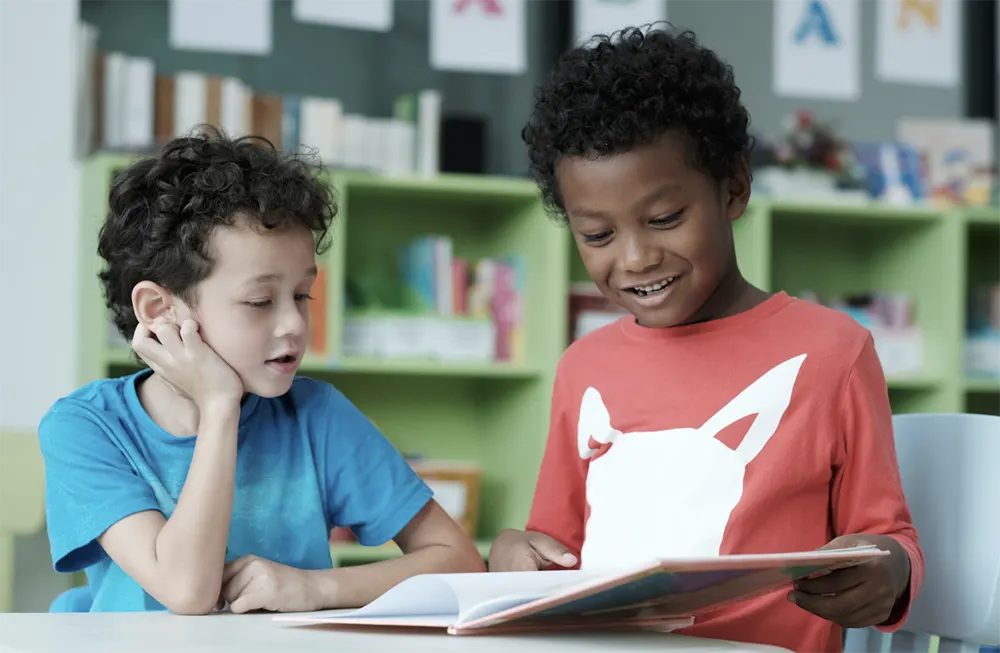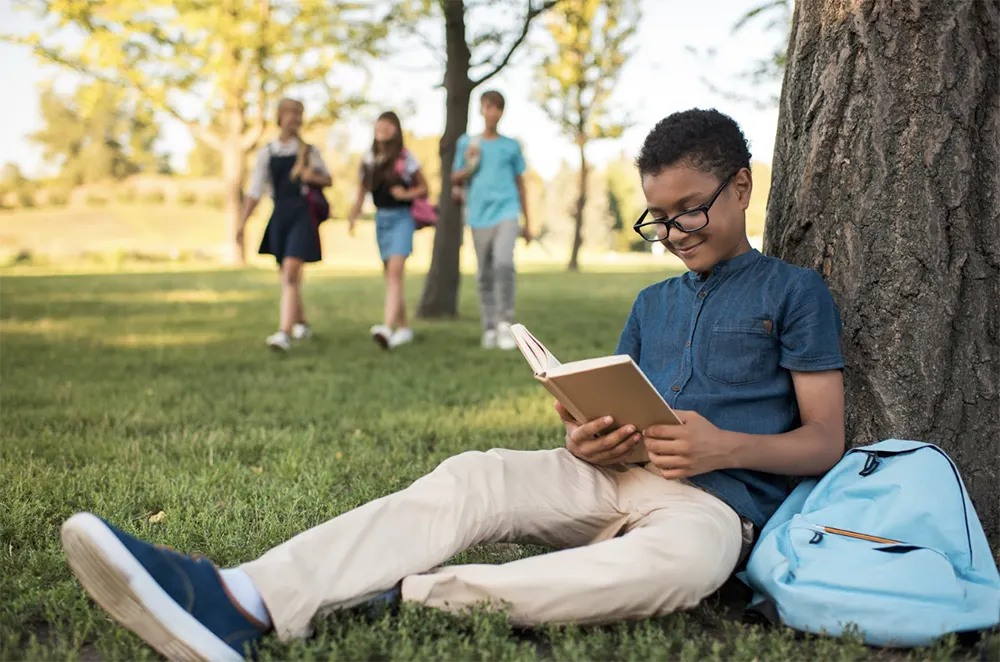BOYS WILL BE BOYS
Keeping Boys Engaged in Reading
Introduction | Background Knowledge | Activities | Extensions | Standards

Introduction
Boys.
We've all heard about boys. They are loud. They are active. They shout out answers. Their handwriting is a mess. They don't like to talk. They don't like school. They are better at math and science. They do not like to read. Boys are falling behind in education.
Research shows there are biological differences between how boys learn and how girls learn. Boys' brains develop more slowly than girls. Research shows that these differences are statistically insignificant. Studies show that girls are more self-disciplined than boys. Studies show that boys are more likely to be diagnosed with ADHD. The research is all over the place and can support a variety of positions.
Some people say that boys and girls should be separated for education. Critics say that both genders are more successful when girls are in the classroom.
Many parents will tell you that there is a huge difference between raising a boy and raising a girl.
How do you get boys interested in reading and keep them interested when so many other choices exist?

Background Knowledge
Surveys have reported that about 40% of elementary-aged boys read for pleasure almost every day. This data from 2020 shows a decrease from 2012. The number of middle and high school students decreases, with 17% of boys reporting that they read for pleasure almost daily. Those boys who report reading for pleasure are historically more successful on reading assessments such as the NAEP.
According to some research, girls learn to read more quickly than boys, but boys rapidly catch up with instruction. Girls also acquire language faster than boys, using complex sentences before their male counterparts. Boys are also more likely to be diagnosed with attention-related disabilities and are more likely to be identified for special education.

Activities
-
Boys benefit from explicit, structured instruction.
- Learn more about the Science of Reading (TeachersFirst review) and Evidence-Based Reading Instruction to provide clear, structured instruction.
- Provide structured instruction using EduProtocols. Learn more by visiting the EduProtocols site and by watching archives of OK2Ask: Engage & Inspire with EduProtocols and OK2Ask: Engage & Inspire with More EduProtocols.
-
Choice of reading materials has been found to encourage reading success.
- Boys typically prefer nonfiction texts, including magazines and newspaper articles. Find a list of free materials here.
- Graphic novels are a great way to engage boys. Consider the titles suggested by the American Library Association.
- Consider titles from this list that may appeal to boys.
- Podcasts are often a gateway to encouraging students to explore their interests, find new ideas, and introduce them to new reading material. Discover educational podcasts suitable to meet the many needs of boys (and all students) in your class by exploring TeachersFirst Educational Podcasts for Students.
-
Give boys great role models.
- Consider the Guys Read series compiled by Jon Scieszka. These volumes of short stories were curated with boys in mind. The topics include those that are most likely to appeal to boys - humor, sports, thrillers, scary stories, heroes, and villains.
- Show pictures and videos of men reading. Create posters of men in the building or in the district reading their favorite books. Storyline Online (TeachersFirst review) has videos of celebrities reading books for students. Search for authors reading their own books or look through the compilation here.
-
Books should be mirrors, windows, and sliding glass doors.
- Books should be mirrors. The reader should see themselves and their lives on the page. Books should be windows. The reader should read about people and lives that are different from their own. Books should be sliding glass doors. The reader should be immersed in the story and empathize with the characters and their challenges.
- Look at stories from different perspectives. Read fractured fairy tales such as The True Story of the Three Little Pigs (ISBN 978-0140544510) or Stinky Cheese Man and Other Fairly Stupid Tales (ISBN 978-0670844876) by Jon Scieszka.

Extensions
-
Different Perspectives
- Read Once Upon a Cool Motorcycle Dude by Kevin O'Malley (ISBN 978-0802789471), a fairy tale written by the two main characters - one boy and one girl. Students can pair up and write fairy tales from differing perspectives. They can publish their stories using WriteReader (TeachersFirst review)
- Teach students how to explore information using the Six Hats Thinking Method. Learn more about this technique from this recent blog post. Create a collaborative whiteboard using the Six Hats template available at IdeaBoardz (TeachersFirst review).

Correlation to Standards
-
AASL National School Library Standards
- Inquire Shared Foundation, Think Domain - Learners display curiosity and initiative by: 1. Formulating questions about a personal interest or a curricular topic. 2. Recalling prior and background knowledge as context for new meaning
- Inquire Shared Foundation, Share Domain - Learners adapt, communicate, and exchange learning products with others in a cycle that includes: 1. Interacting with content presented by others. 2. Providing constructive feedback. 3. Acting on feedback to improve. 4. Sharing products with an authentic audience.
- Include Shared Foundation, Share Domain - Learners exhibit empathy with and tolerance for diverse ideas by: 1. Engaging in informed conversation and active debate. 2. Contributing to discussions in which multiple viewpoints on a topic are expressed.
- Include Shared Foundation, Grow Domain - Learners demonstrate empathy and equity in knowledge building within the global learning community by: 1. Seeking interactions with a range of learners.
- Collaborate Shared Foundation, Think Domain - Learners identify collaborative opportunities by: 1. Demonstrating their desire to broaden and deepen understandings. 2. Developing new understandings through engagement in a learning group. 3. Deciding to solve problems informed by group interaction.
- Collaborate Shared Foundation, Create Domain - s Learners participate in personal, social, and intellectual networks by: 1. Using a variety of communication tools and resources. 2. Establishing connections with other learners to build on their own prior knowledge and create new knowledge.
- Collaborate Shared Foundation, Grow Domain - Learners actively participate with others in learning situations by: 2. Recognizing learning as a social responsibility.
- Explore Shared Foundation, Think Domain - Learners develop and satisfy personal curiosity by: 1. Reading widely and deeply in multiple formats and writing and creating for a variety of purposes.
- Explore Shared Foundation, Create Domain - Learners construct new knowledge by: 1. Problem solving through cycles of design, implementation, and reflection.
- Explore Shared Foundation, Share Domain - Learners engage with the learning community by: 3. Collaboratively identifying innovative solutions to a challenge or problem.
- Explore Shared Foundation, Grow Domain - Learners develop through experience and reflection by: 1. Iteratively responding to challenges. 2. Recognizing capabilities and skills that can be developed, improved, and expanded. 3. Open-mindedly accepting feedback for positive and constructive growth.
-
ISTE Standards for Students
- Empowered Learner - 1b. Students build networks and customize their learning environments in ways that support the learning process. 1c. Students use technology to seek feedback that informs and improves their practice and to demonstrate their learning in a variety of ways.
- Knowledge Constructor - 3d. Students build knowledge by actively exploring real-world issues and problems, developing ideas and theories, and pursuing answers and solutions.
- Innovative Designer - 4d. Students exhibit a tolerance for ambiguity, perseverance, and the capacity to work with open-ended problems.
- Global Collaborator - 7c. Students contribute constructively to project teams, assuming various roles and responsibilities to work effectively toward a common goal.
